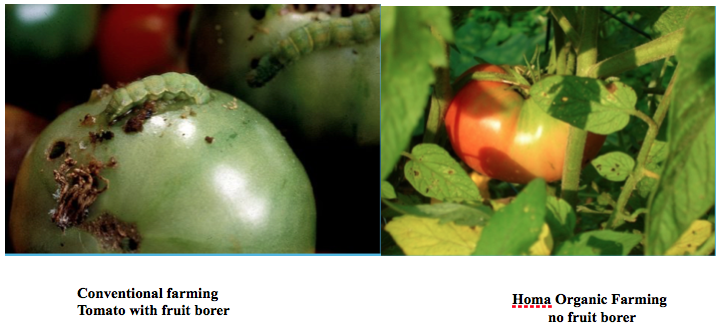
Scientific Aspects of Agnihotra: Agriculture – Pests and Diseases (Part 11)
By Dr. Ulrich Berk
Germany

Vedic knowledge says that when we perform Agnihotra, a channel is created above the pyramid, going up 12 kilometers.
Prana energy – Life Energy – which lies above our atmosphere, comes down through this channel. Because of pollution, this flow of Prana energy might be blocked otherwise.
When the Prana reaches the Agnihotra pyramid it creates an aura energy field around all plants in the vicinity, which lasts as long as the flame is there.
This makes plants stronger and disease-resistant.
Also it is said that Agnihotra brings Nature back to harmony.
Can these statements be confirmed by modern science?
There are many reports from people who have experienced that pests and diseases got controlled in their gardens and farms. The first systematic studies done by agricultural engineers were done approximately 20 years ago in South America, mainly in Peru. A fungal disease called Black Sigatoka affected banana plantations on a large scale, destroying up to 90% of the crops. This was especially severe, as in South America banana is a staple food for most of the population. Chemical remedies did not work for more than one season – after that the fungal population had become resistant to these fungicides. Many farmers were about to give up their banana plantations, and on one of these farms Homa Organic Farming was started, using the resonance technique (in which ten Agnihotra pyramids are energized and arranged in a special configuration, so that by resonance a large area up to 80 hectares can be covered). According to reports of government engineers, Black Sigatoka infection could be totally eradicated:

There were some quite astonishing reports of how Homa Organic Farming methods have helped to control diseases and pest infestation. I just want to mention two of those before going to some systematic studies on the subject.
The first report was from Karin Heschl about tomatoes in Jaipur area, India. Farming was done with agrochemicals, and the tomatoes were heavily infested with tomato fruit borer.
All the tomato farms in the village were affected. Heavy doses of chemical insecticide were needed 3 times per week.
In one farm Homa Farming was started. After three months of treatment with Homa Therapy the pest infestation was completely controlled.
The subsequent plantings after beginning Homa Therapy treatment were not infested at all.
Also the yield was double that of the other farmers in the village.

The second report came from Abhay Mutalik Desai, a Homa Organic Farmer from Belgaum area, Karnataka, India. He was growing sugar cane for several years with Homa Farming methods on a 20 acre farm and got good results.
Then in 2005, his plants were surprisingly attacked by woolly aphid. As this should not have happened, he checked whether the Homa Farming methods were done properly on the farm and found out that the farm manager had bought ghee from the market which was not pure cow’s ghee. Immediately he got pure cow ghee (and then bought some cows for the farm so that they could produce their own ghee). Immediately after the Homa fires were done with proper ghee, two natural predators – Micromus igorotus and Dipha aphidivora – came automatically and controlled the woolly aphid, and again they had lush, green, healthy sugar cane.
Interestingly, the predators started from the area where the woolly aphid had first appeared.
These two examples show how Homa Farming helps to bring Nature back to harmony.
Later on, more systematic research on the effects of Homa Organic Farming on pests and diseases was conducted in India. We already had mentioned four M.Sc. studies done at the Agricultural University in Dharwad, Karnataka, India, and last time we reported the results regarding yield of soy beans, cabbage, tomatoes, and okra. Now let us see the results regarding diseases and pests.
Soy beans
- Decrease in the incidence of rust (16-29%) and insect attack (18-43%) were observed due to different Homa treatments.
- Foliar application of Biosol was found to be effective in the control of rust, pod borer and the control of caterpillar.
Cabbage
- Decrease in the incidence of black rot (29-55%) and black spot of leaf (39-73%), head borer (18-69%), number of diamond back moth larvae per plant (25-64%) and Spodoptera litura larvae per plant (40-62%) were observed due to different Homa treatments as compared with organic control not exposed to Homa treatment, but organic control with Homa and conventional control did not differ significantly.
Tomatoes
- Decrease in the incidence of leaf spot (37%) and insect attack (40%) was observed as compared with Gloria Biosol and organic control due to different Homa treatments.
Okra
- Decrease incidence of Powdery mildew (19-36%) and Alterneria leaf spot (30-57%), fruit borer (16-38%), and Spodoptera litura larvae per plant (48-68%) were observed due to different Homa treatments as compared with conventional control.
These studies show significant reduction in pest infestation and in diseases. The areas of Homa Farming and control were approximately one kilometer apart – which may not be enough to exclude some positive effect of the Homa atmosphere also in the control area. Normally, we advise having these two plots at least three kilometers beeline apart. But even as this distance was not kept they had good, convincing results.
